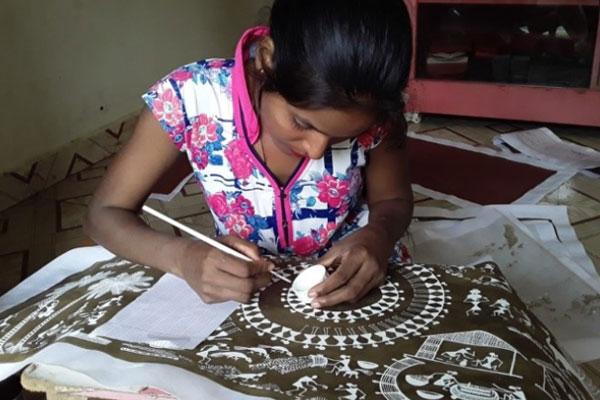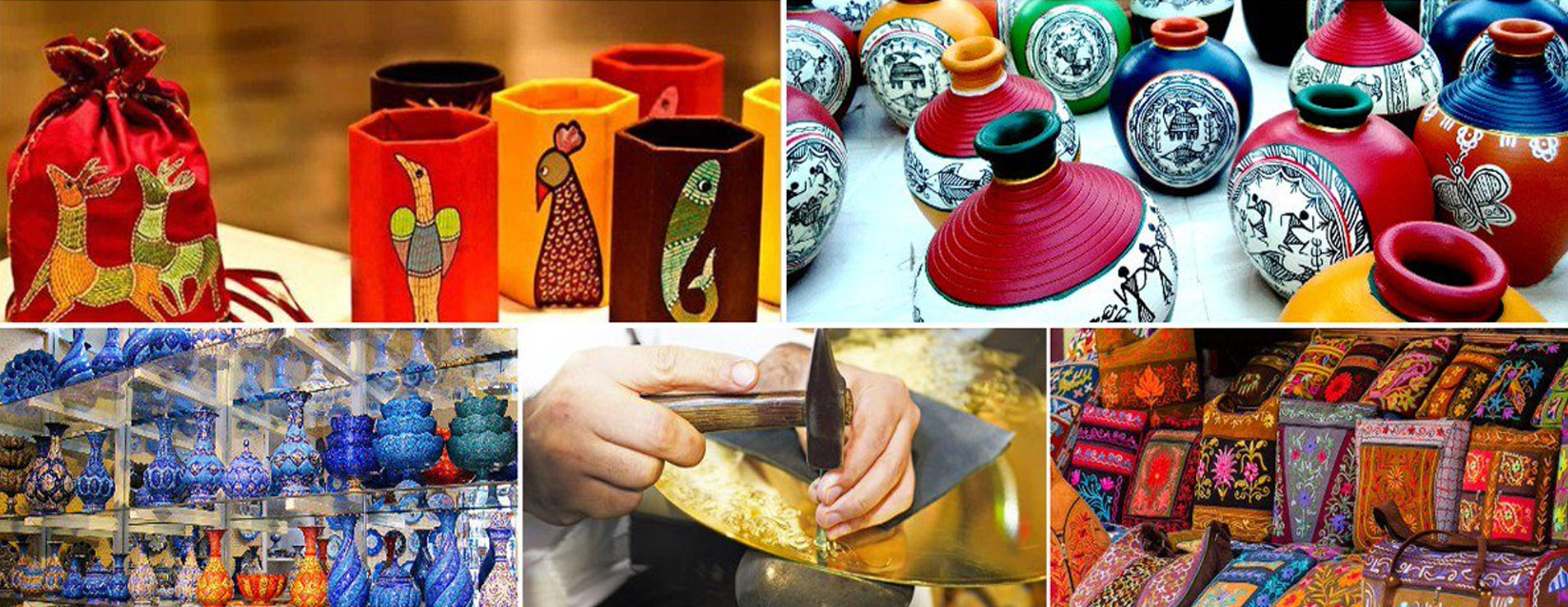
Art Work Story
Applique Work
Applique, derived from a French word, is defined as an art form of coloured fabrics. Applique work is an art form that uniquely represents the state of Orissa, as this art is a speciality of the skillful and talented artisans of Pipli village. An art that began roughly 850 years ago, it has continued to prosper till date.
The various types of applique work include Bana, Mandant, Adhoni, Alata, Trasa, Chhati, Chandua and many more. All these types of art are used during ceremonies associated with Lord Jagannath. Originally, this art form initiated as temple art. Artisans make various decorative articles such as umbrellas and torans, using small coloured cloth pieces, which they cut and fold into different shapes. These include leaves, flowers, animals, birds and other motifs. Later, they stitch these shapes on to larger pieces of cloth. The colours used by the Pipli artisans largely comprise red, white, green, purple, yellow and black.
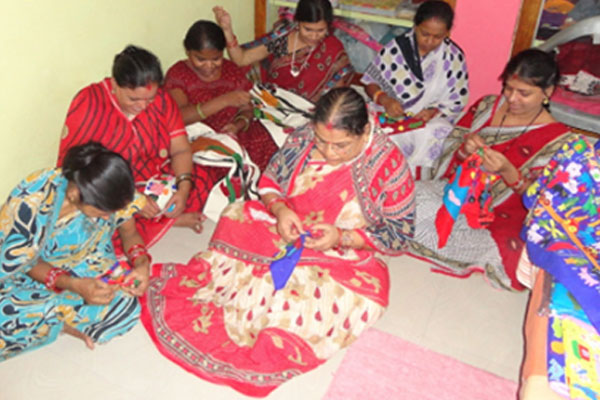
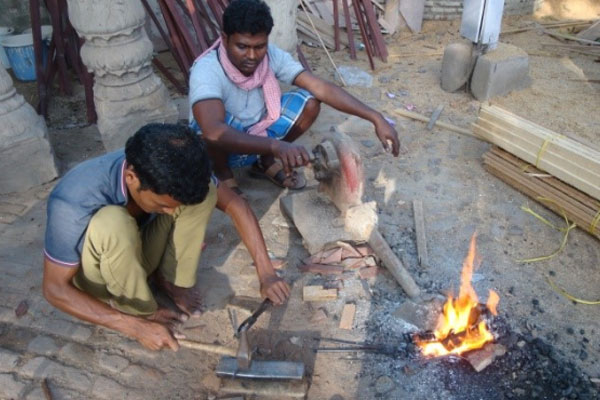
Bastar Tribal Iron Work
Bastar Iron Craft (also known as the ‘wrought iron craft of Bastar’) is a centuries-old traditional Indian iron craft that is manufactured in the Bastar district of Chhattisgarh state, India. This iron craft skill has been passed on from generation to generation in the Bastar region.
The Bastar region of Chattisgarh is one of the richest areas in terms of iron ore deposits. Tribes, particularly Gond and Maria, specialized in extracting iron from the iron ores, thus forming ironsmith communities in the tribe. The community started catering to the needs of the tribe by providing them with tools for agriculture, jungle cutting tools, arrowheads and knives for hunting. Their skill evolved with time as well as experimentation with materials and techniques.
The Gond tribe worships ‘Budhadev’ as God, which was believed to reside in the ‘saja’ tree, also known as the Indian laurel. The tree was used for rituals and was believed to be sacred. It was considered a symbol of strength by the local tribes. But slowly when Gonds understood the strength of iron, they started believing that their God was in iron too. Ironsmiths then started experimenting by making religious art forms. They created wrought iron lamps (diyas) and also decorated these with animal motifs. They started making figurines of ‘Budhadev’ riding a horse. As their art evolved with time, their work also got noticed.
Gond Tribal Art
Gonds are one of central India’s largest indigenous communities spread over the state of Madhya Pradesh, and their art is an expression of their everyday quest for life. Gond art reflects the belief that “viewing a good image begets good luck”. This inherent belief led the Gonds to decorate their houses and their floors with traditional tattoos and motifs. However, Gondi art has since transposed onto paper and canvas with talented artists showcasing their skills. The language of the soul is expressed in the brilliant hues of Gondi art. Gond painters have created their own signatures using patterns. Some draw circles, while some draw lines, some use myriad colours, while some stick to black and white. These signature styles are the essence of this tribal art form and are decorative patterns and motifs. The allusiveness and individualism of each Gond artist is defined by these signature styles.
Gond artists begin their paintings by drawing an outline, which is then filled with block colours. This is left to dry, then elaborate patterns are painted on top, which give the designs their distinct three-dimensional quality. This time-consuming patterning process requires great precision from the artist.
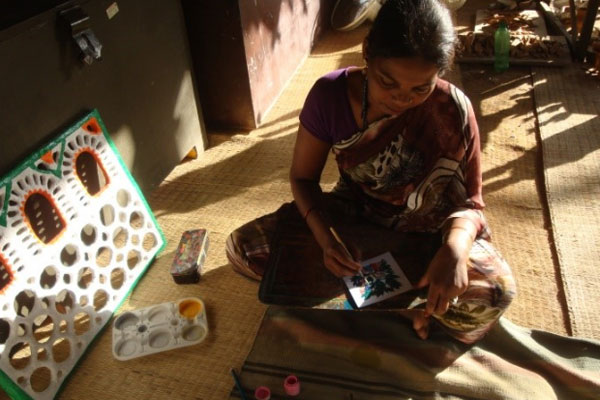
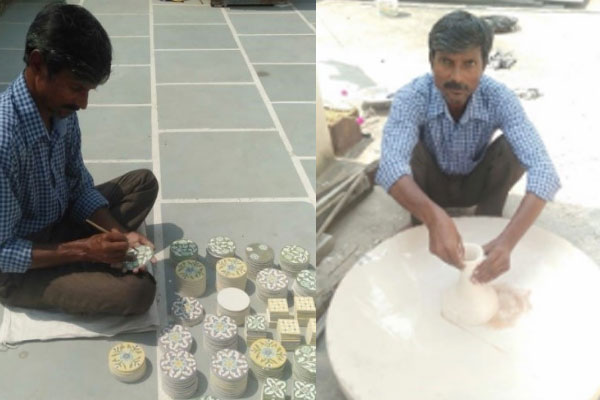
Hand-Made Tile Work
Blue Pottery is widely recognized as a traditional craft of Jaipur, though it is Turko-Persian in origin. The name ‘blue pottery’ comes from the eye-catching blue dye used to colour the pottery.
Jaipur blue pottery, made out of a frit material similar to Egyptian faience, is glazed and low fired. No clay is used: the dough for the pottery is prepared by mixing quartz stone powder, powdered glass, Multani mitti, borax, gum and water. ‘Katira Gond’ powder (a gum) and ‘Saaji’ (soda bicarbonate) are also used as ingredients.
Some of this pottery is semi transparent and mostly decorated with bird and other animal motifs. Being fired at very low temperature makes them fragile. The range of items is primarily decorative, such as ashtrays, vases, coasters, small bowls and boxes. The colour palette is restricted to blue derived from cobalt oxide, green from copper oxide, and white, though other non-conventional colours, such as yellow and brown are also sometimes included.
The use of blue glaze on pottery is an imported technique, first developed by Mongol artisans who combined Chinese glazing technology with Persian decorative arts. This technique travelled east to India with early Turkish conquests in the 14th century. During its infancy, it was used to make tiles to decorate mosques, tombs and palaces in Central Asia. Later, following their conquests and arrival in India, the Mughals began using blue glaze in India. Gradually, the blue glaze technique grew beyond an architectural accessory to Indian potters. From there, the technique travelled to the plains of Delhi and in the 17th century went to Jaipur.
Jaali Stone Work
Agra in Uttar Pradesh is famous for two forms of stone cutting craft, the first being Jaali work or stone tracery, which involves carving a single piece of marble and the second being ‘Parchin Kari’ or the art of inlaying precious and semi-precious stones in marble. This decorative art of stone tracery was introduced in Agra on a large scale by Mughal rulers during the medieval period. Jaali was not only used for decoration, but it also served the purpose of providing free ventilation, which is very necessary for the harsh climatic conditions of northern India. The stone jaali work is almost entirely used for architectural purposes. In Agra, artisans tend to replicate the same marble carving techniques of jaali to make small fret-cut boxes and other articles such as lamps, shades and ornamental boxes.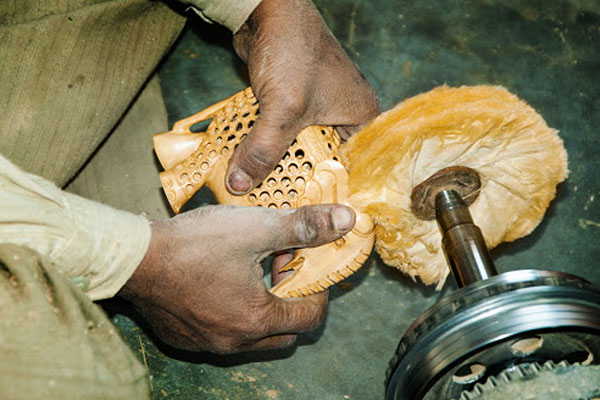
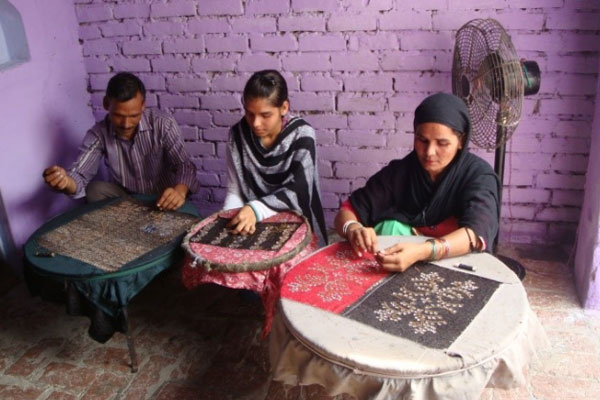
Kundan Zardozi Work
The word Zardozi is a combination of two Persian words, Zar meaning gold and Dozi meaning embroidery. The process of Zardozi embroidery starts with craftsmen sitting cross-legged around the Addaa, or the wooden framework, with their tools. These tools include curved hooks, needles, ‘salmaa’ pieces (gold wires), ‘sitaaras’ (metal stars), round-sequins, glass and plastic beads, ‘dabkaa’ (thread) and ‘kasab’ (thread). The second step in the process is tracing out a design on cloth. The fabric is then stretched over the wooden frame and the embroidery work begins. A needle is used to pull out each zardozi element and then it is integrated into the basic design by pushing the needle into the fabric.
Kundan zardozi embroidery is beautiful metal embroidery, which was once used to embellish the attire of Kings and other royalty in India. It was also used in wall hangings. Zardozi embroidery involves making elaborate designs, using gold and silver threads. Studded pearls and precious stones added to the magnificence of zardozi work. Zardozi embroidery has been in existence in India from the time of the Rig Veda. There are numerous instances that mention the use of zari embroidery as ornamentation for the attire of gods. Initially, the embroidery was made using pure silver wires and real gold leaves. However, today, craftsmen make use of a combination of copper wire, with a golden or silver polish, and a silk thread. This is because there is hardly any availability of gold/silver on such a large scale as earlier. Zardozi embroidery work is mainly a speciality of Bhopal, Hyderabad, Delhi, Agra, Kashmir and Ajmer.
The decline of the craft occurred under the rule of Aurangzeb, during which royal patronage stopped. Since the cost was high and raw materials quite rare, craftsmen could not carry on with the embroidery on their own. Many craftsmen left Delhi and went to the courts of Rajasthan and Punjab in search of work. With the 18th and 19th century bringing industrialization, the craft suffered further setback. However, after India gained independence in 1947, the Indian government undertook steps to revive and promote zari embroidery.
Leather Painting
Leather puppetry is called ‘tholubommalata’ in Telugu. The word ‘tholu’ means leather and ‘bommal-ta’, playing with leather dolls or figurines. It was once presented by indigenous Telugu folk artistes known as ‘atagollalu’ (cowherd players) who belong to the Jangama (Saivite mendicants) and Balija castes. Puppets are made of goat or buffalo skins. These hides are tanned, made translucent and cut into various shapes and sizes. First, an artist draws an outline on a leather skin with pencil or charcoal, and then punches holes in the skin. The colouring of puppets is an elaborate process. After the paints dry, the leather cut out is shaped with a sharp-edged knife. In this style, generally, icons and images of historical characters are etched out such as kings, queens, army men, jesters, buffoons and clowns. Other images include those of natural scenes, trees and plants, flowers, birds and animals. Vegetable colours were used till the middle of the 20th century, but now chemical dyes are favoured for their cost effectiveness and easy availability.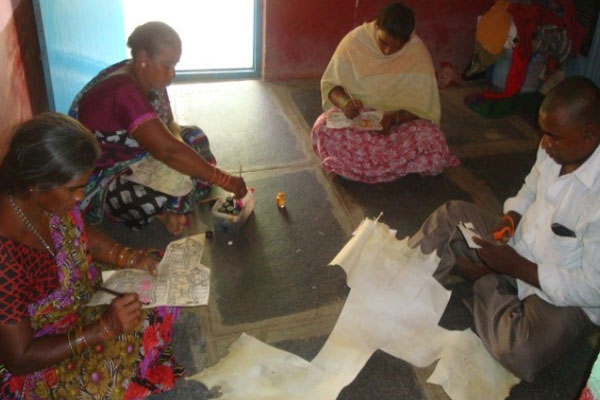
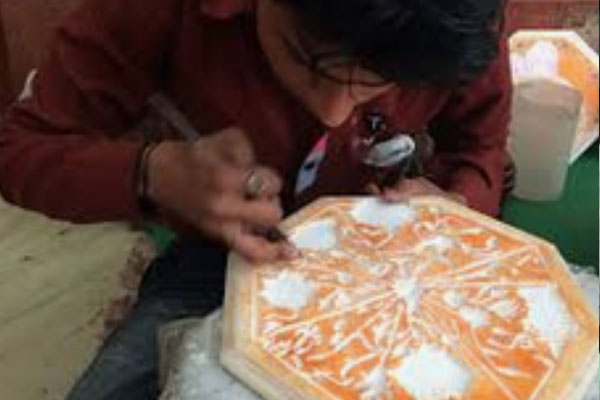
Marble Inlay Work
This marble-based art work is mainly carried out in two places in India, namely Rajasthan and Agra in Uttar Pradesh. While Rajasthan is noted for its inlay work on table tops, flooring and wall decoration, Agra is known for its ‘Parchin Kari’ art, which involves very minute and precise inlay work that is quite expensive and involves intricate labour. Among the various stone arts that flourished in the country, the most famous was the marble inlay or crafting work. This art flourished and reached its peak during the Mughal era in Medieval India and especially after the construction of the Taj Mahal. It is believed that initially during the early 17th century in Italy, minute inlay work was done on different forms of precious stones and this was referred to as ‘pietra dura’ wherein ‘pietra’ represents stone and ‘dura’ represents anything hard. The Italians were outstanding in this classic art and in fact held an exclusive possession over this art.
There are different varieties and varying qualities of stones with beautiful colours and textures, and semi-precious stones. Some semi-precious stones include lapis lazuli, malachite, sodalite, amethyst, tiger’s eye and white and green marbles, which are used as decorative stones. The most distinguished material used in inlay work is mother of pearl. First, the craftsman draws a perfect sketch of the pattern. Next, the semi-precious stone is sliced (stone slices range between 4 and 7mm). It is then cut according to the required shape and size. Later, the base stone is marked with care for the further process of engraving. Once the base stone is ready, the different slices of the coloured stones are fixed on the appropriate engraved stone with the help of special glues. Then the entire work including the surface and the edges are finely polished and buffed up to give a glossy and gleaming rich look.
Mithila Art
Madhubani or Mithila painting is a folk art of Madhubani in Bihar. Initially, Mithila paintings adorned the mud walls of rural homes. However, nowadays, Mithila paintings are largely made on paper. It is mostly practiced by village women who have passed this art form to their daughters through multiple generations. They paint pictures of nature and mythology to depict different events such as birth and marriage. It is an art that is at least 2,500 years old.
The paintings are traditionally based on mythological and folk themes and pastoral symbols. The central themes of most paintings are love, valour, devotion, and fertility, though the approaches may vary. Therefore, the commonly found scenes of Mithila art include those of courtship and marriages and symbols of fertility and prosperity such as fish, parrot, elephant, tiger, turtle, sun, moon, bamboo and trees. While divine beings are positioned centrally in the frame, their consorts and floral motifs form the background. Human figures are mostly abstract and linear in form.
Nowadays, despite the increasing use of synthetic colours, traditional artists continue to make their own colours by extracting these from plants. The colouring is of two styles – ‘Kachni’ (hatching) and ‘Bharni’ (shading). While Kachni uses delicate fine lines to fill the painting without using much colour, Bharni (shading) uses solid colours to shade and fill the pictures. In Bharni, black outlines are filled with vibrant colours.
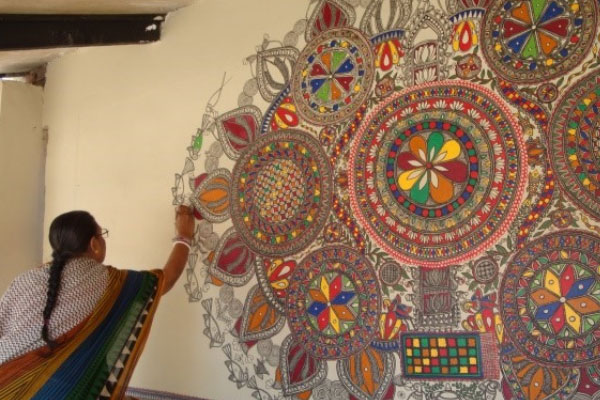
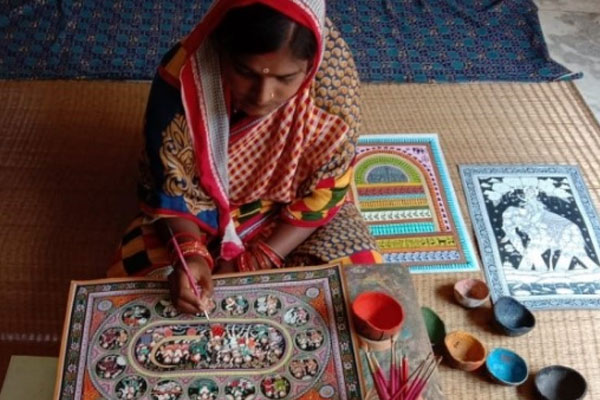
Pattachitra Art
Pattachitra is a general term for traditional, cloth-based scroll paintings, based in the eastern Indian state, Odisha. ‘Patta’ literally means ‘cloth’, while ‘chitra’ means ‘picture’ in Sanskrit. While the Pattachitra painting tradition is closely linked with the worship of Lord Jagannath, stories from the Ramayana, Mahabharata, and Radha and Krishna form the other main themes. Pattachitra paintings resemble the old murals of Odisha, especially those in the religious centres of Puri, Konark and Bhubaneswar regions, dating back to the 5th century B.C. However, the best work was found in Puri, especially in the village of Raghurajpur. Nowadays, Pattachitra artists have also begun using a variety of non-religious themes in their painting.
Palm Leaf pattachitra is known as Tala pattachitra in the Oriya language. The unripe leaves of the palm tree are first cut and semi dried to prepare the palm leaf. Next, the leaves are buried in swamps for four to five days for seasoning and later dried in the shade. These are then strung together or stitched as per the need. Sometimes, after the completion of etching, these are stitched together. The etching is done on leaf strips using an iron pen. To highlight the figures, a paste made of bean leaves, charcoal made of burnt coconut shells, til oil and turmeric is rubbed on the etching. Subdue tones are used, and colours are hardly present in this art. Artists use vegetable and mineral colours for painting. Palm leaf artists enhance the beauty of their paintings with the themes of mythological incidents, the figures of gods and goddesses complete with details of their hairstyles and dresses, the figures of animals, flowers and trees, etc. Durga, Ganesha, Saraswati, Radha and Krishna are the most commonly used pattachitra themes.
Sanjhi Art
Sanjhi art is the traditional art of stencilling from Mathura, God Krishna’s hometown in Uttar Pradesh, India. Craftsmen use specially designed scissors to accomplish this process. It is a truly unique craft form that features exquisite designs and intricate picture motifs, cut into paper. Known for its inherent spiritual implications that reach beyond immediate aesthetic appeal, Sanjhi art is considered to be one of the finest arts of spiritual expression. The art grew in the 16th and 17th centuries, when the walls and floors of temples were decorated with Sanjhi motifs. The term Sanjhi is derived from the Hindi word ‘sandhya’, the period of dusk with which the art form is typically associated.
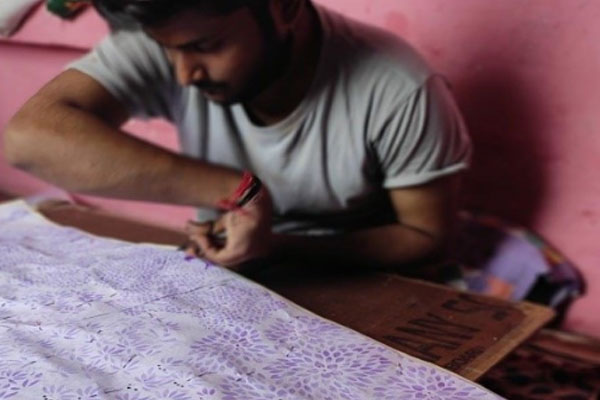
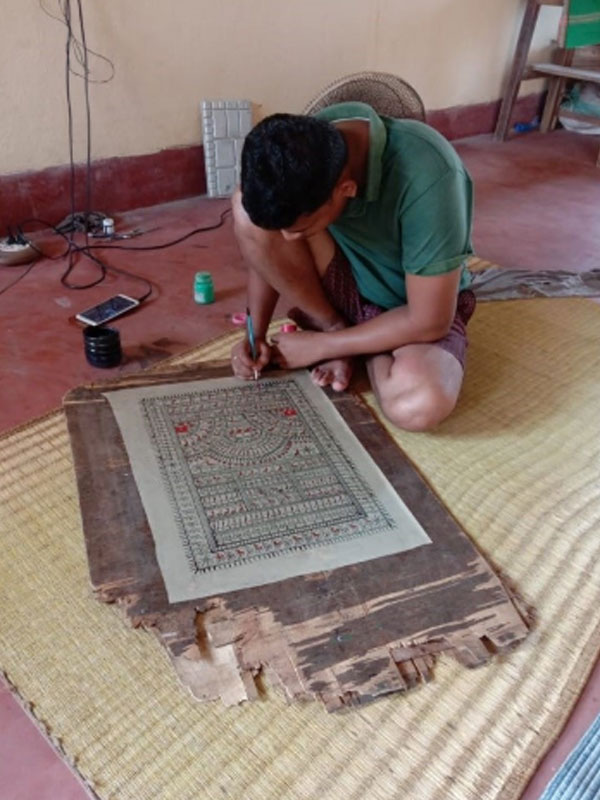
Saura Tribal Art
With simple forms and figures that come together to compose intricate narratives in very few colours, the captivating art of the Sauras, has told the story of the tribe for hundreds of years. A tribal art form from eastern India, Saura art originated as a ritualistic art form that decorated the walls of village homes. However, gradually, it grew to become one of the most beautiful art forms of India.
The Sauras are one of India’s oldest tribes inhabiting the southern part of Odisha. With a history that has been mentioned in the Ramayana and the Mahabharata, the Sauras are known for their distinct tribal culture and their art. They are also a tribe that is deeply connected to nature.
Saura art is traditionally made on the red or brown clay walls of village homes using natural dyes made from rice, white stone, and flower and leaf extracts, using a brush that is made from tender bamboo. The paintings are usually dedicated to the deity of the Sauras, known as ‘Idital’ and are made during special occasions such as harvest, child birth and marriage, during which the deity is also worshipped.
The figures in Saura artworks are called icons or ‘ikons’, and many of these are recurring motifs and symbols, such as the ‘pipal’ tree, the tree of life, the sun and the moon, horses and elephants, all of which have their own symbolisms.
How Saura Differs from Warli:
At first glance, Saura seems to be the identical twin of another, perhaps better known tribal art form from India – Warli. Made of similar geometrical shapes, and in similar shades of earthen colours, the two art forms are often indistinguishable.
The Saura figures are less angular than the Warli ones, where the human body is depicted by two sharp triangles conjoined at the apex. The Saura forms are also larger and more elongated than the ones seen in Warli art, with no physical differentiations between male and female shapes. Another distinct characteristic of Saura art is the ‘fishnet’ approach with which all the art works are made. Every Saura art work begins with a carefully drawn border and then the patterns closes in on the centre to form intricate compositions.
There are different varieties and varying qualities of stones with beautiful colours and textures, and semi-precious stones. Some semi-precious stones include lapis lazuli, malachite, sodalite, amethyst, tiger’s eye and white and green marbles, which are used as decorative stones. The most distinguished material used in inlay work is mother of pearl. First, the craftsman draws a perfect sketch of the pattern. Next, the semi-precious stone is sliced (stone slices range between 4 and 7mm). It is then cut according to the required shape and size. Later, the base stone is marked with care for the further process of engraving. Once the base stone is ready, the different slices of the coloured stones are fixed on the appropriate engraved stone with the help of special glues. Then the entire work including the surface and the edges are finely polished and buffed up to give a glossy and gleaming rich look.Warli Tribal Art
Warli painting is a tribal art form, which is mostly practiced by the adivasis from the North Sahyadri range in India. The warlis carry on a tradition stretching back to 2500 or 3000 SCE.
This form of painting requires both special skills and a special type of mixture. First, the area where the paintings are to be made is coated with a mixture. This mixture usually consists of clay, cow dung and water. After the three elements are mixed thoroughly, the surface is coated with this mixture using a cloth. After the first coat dries up, two to three more coats of the mixture are applied on the surface to give it a brighter appearance. It is allowed to dry completely, and this forms the base or the canvas for the art.
The drawings are made using rice powder. Although it may sound strange, the secret behind this art is, ‘rice powder’. Rice is soaked in water for the whole night and then a thick paste is made out of it using mortar and pestle. While many tribal people draw the paintings using their fingers, these days, bamboo sticks are also being used. The tribals chew one end of the stick, which acts as a paint brush. This brush is then dipped into the rice paste and then drawings are made on the walls.
These paintings are mostly a combination of geometric shapes, which include squares, circles and triangles. These three shapes hold special relevance in Warli paintings. Circles and triangles mostly represent the elements of nature. For example, triangles are used to depict hills, mountains, trees and even human shapes. On the other hand, circles are used to depict the sun and the moon. Squares have an altogether different significance in these paintings. They represent the unknown or an invention. Squares usually depict discoveries such as secret places, caves, and land. The painting series centralises around activities such as dancing, fishing, farming, human shapes, wildlife, ceremonies and festivals.
